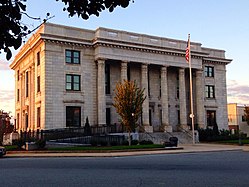Graham, North Carolina | |
|---|---|
 | |
 Location of Graham, North Carolina | |
| Coordinates: 36°03′30″N79°23′20″W / 36.05833°N 79.38889°W | |
| Country | |
| State | |
| County | Alamance |
| Founded | 1849 |
| Incorporated | 1851 |
| Named after | William A. Graham [1] |
| Government | |
| • Mayor | Jennifer Talley |
| Area | |
• Total | 10.49 sq mi (27.17 km2) |
| • Land | 10.42 sq mi (26.99 km2) |
| • Water | 0.069 sq mi (0.18 km2) |
| Elevation | 594 ft (181 m) |
| Population (2020) | |
• Total | 17,157 |
| • Density | 1,646.4/sq mi (635.66/km2) |
| Time zone | UTC−5 (Eastern (EST)) |
| • Summer (DST) | UTC−4 (EDT) |
| ZIP code | 27253 |
| Area code | 336 |
| FIPS code | 37-27280 [4] |
| GNIS feature ID | 2403722 [3] |
| Website | cityofgraham.com |
Graham is a city and the county seat of Alamance County, North Carolina, United States. It is part of the Burlington, North Carolina Metropolitan Statistical Area. As of the 2020 census the population was 17,153. [5] [6]




